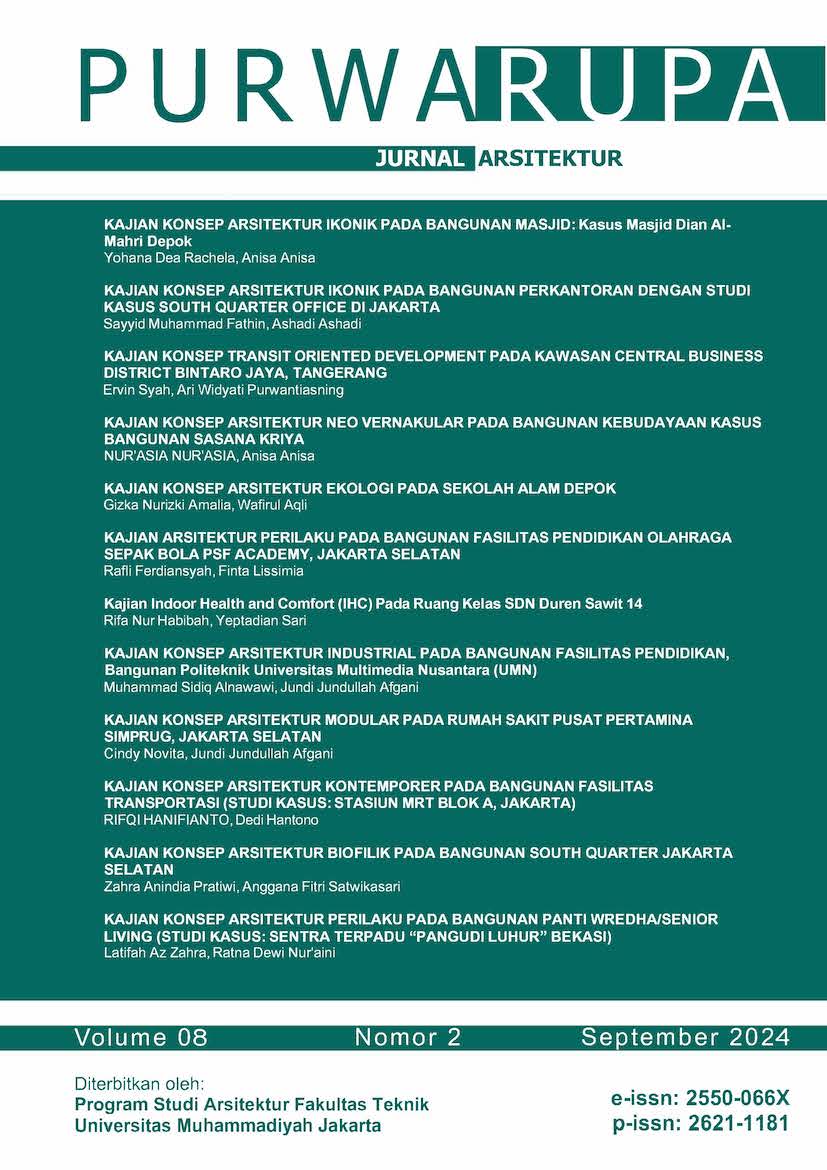Kajian Indoor Health and Comfort (IHC) Pada Ruang Kelas SDN Duren Sawit 14
DOI:
https://doi.org/10.24853/purwarupa.8.2.137-142Abstract
ABSTRAK. Ruang kelas, yang sering padat diisi dengan murid dan guru, digunakan selama 5 hari seminggu dengan durasi 5-8 jam per hari, dan dapat menampung 10-38 orang. Hal ini dapat dengan mudah menularkan penyakit, terutama jika ruang kelas tidak memenuhi standar kesehatan.Melihat banyaknya faktor yang mempengaruhi keberhasilan kegiatan belajar mengajar, maka diperlukan ruang kelas yang sehat dan nyaman. Oleh karena itu, perlu diteliti konsep Kesehatan dan Kenyamanan dalam Ruang (Indoor Health & Comfort/IHC) pada Sekolah Dasar, dengan studi kasus SDN Duren Sawit 14 yang terletak di Jakarta Timur. Metode yang digunakan adalah deskriptif kualitatif dan tujuan penelitian ini untuk memahami dan mengidentifikasi kualitas Kesehatan dan Kenyamanan dalam ruang pada ruang kelas di bangunan pendidikan SDN Duren Sawit 14. Hasil menunjukkan 6 dari 8 kriteria sudah memenuhi standar dan membuat ruang kelas menjadi sehat dan nyaman. Kata Kunci: Kesehatan dan kenyamanan dalam ruang, Ruang kelas, Sekolah Dasar ABSTRACT. Classrooms, which are often crowded, filled with students and teachers, are used 5 days a week for 5-8 hours per day, and can accommodate 10-38 people. This can easily spread disease, especially if the classroom does not meet health standards. Seeing the many factors that influence the success of teaching and learning activities, a healthy and comfortable classroom is needed. Therefore, it is necessary to research the concept of Indoor Health and Comfort (IHC) in elementary schools, with a case study of SDN Duren Sawit 14 which is located in East Jakarta. The method used is descriptive qualitative and the aim of this research is to understand and identify the quality of indoor health and comfort in classrooms in the educational building of SDN Duren Sawit 14. The results show that 6 of the 8 criteria meet the standards and make the classrooms healthy and comfortable. Keywords: Indoor health and comfort, classroom, junior high schoolReferences
Dalyono, M. (2005). Psikologi Pendidikan. Jakarta: Rineka Cipta.
Ervianti, A. F. (2018). Penerapan Konsep Kesehatan dan Kenyamanan pada. Jurusan Arsitektur Itenas .
Hanifah. (2018). Faktor-Faktor Yang Mempengaruhi Tingkat Kenyamanan Belajar Siswa Di Lingkungan Sekolah Menengah Kejuruan Bina Madina Denpasar Tahun 2018. Diploma Thesis, Jurusan Kesehatan.
Ratnasari, P. N., & Nurwidyaningrum, D. (2022). Perkantoran Bertingkat Rendah Dengan Studi Kasus Gedung Perkantoran PT. X di Jakarta. Construction and material Journal.
Safitri. (2022, September Jumat). Ratusan Siswa Sakit Bersamaan, Alami Gejala Batuk Pilek hingga Demam. Diambil kembali dari Radarjember.id: https://radarjember.jawapos.com/bondowoso/791118518/ratusan-siswa-sakit-bersamaan-alami-gejala-batuk-pilek-hingga-demam#google_vignette
Sobirin, Z. A., & Cahyaka, H. W. (2014). Analisis Kesesuaian Desain Gedung Olahraga Baru Universitas Negeri Surabaya Terhadap Konsep Green Building. Rekayasa Teknik Sipil.
Wardhani, D. K., Susan, Anastasia, M., & Setiando, M. J. (2020). Indoor health and comfort for the green workplace at university. Jurnal Teknik Arsitektur.
Yusuf, A. M. (2014). Metode Penelitian Kuantitatif, Kualitatif dan penelitian Gabungan (Pertama). Jakarta: Kencana.
Downloads
Published
How to Cite
Issue
Section
License
COPYRIGHT POLICY
The author(s) of an article published in the Jurnal Teknologi retains ownership of the intellectual property rights in work (s).
PUBLISHING RIGHTS
The author(s) of an article published in the Jurnal Teknologi have unrestricted publication rights. The authors give the Jurnal Teknologi the right to publish the article and designate the Faculty of Engineering Universitas Muhammadiyah Jakarta Publishing as the original publisher of the article.
LICENSING POLICY
Journal of Mechanical Engineering and Sciences is an open-access journal that follows the Creative Commons Non-Commercial 4.0 International License (CC BY-NC 4.0), which states that:

Under this license, the reusers must give appropriate credit, provide a link to the license, and indicate if changes were made. Users may do so in any reasonable manner, but not in any way that suggests the licensor endorses users or their use.
Please take the time to read the whole license agreement (https://creativecommons.org/licenses/by-nc/4.0/). As long as reusers follow the license conditions, the owner cannot withdraw these freedoms. The following components are included under this license:
 Attribution: Users must provide appropriate attribution, including a link to the license, and indicate whether or not they made any modifications. Users are free to do so reasonably, but not in a manner that indicates the licensee approves of their usage.
Attribution: Users must provide appropriate attribution, including a link to the license, and indicate whether or not they made any modifications. Users are free to do so reasonably, but not in a manner that indicates the licensee approves of their usage.
 NonCommercial: Users may not use the material for commercial purposes.
NonCommercial: Users may not use the material for commercial purposes.

